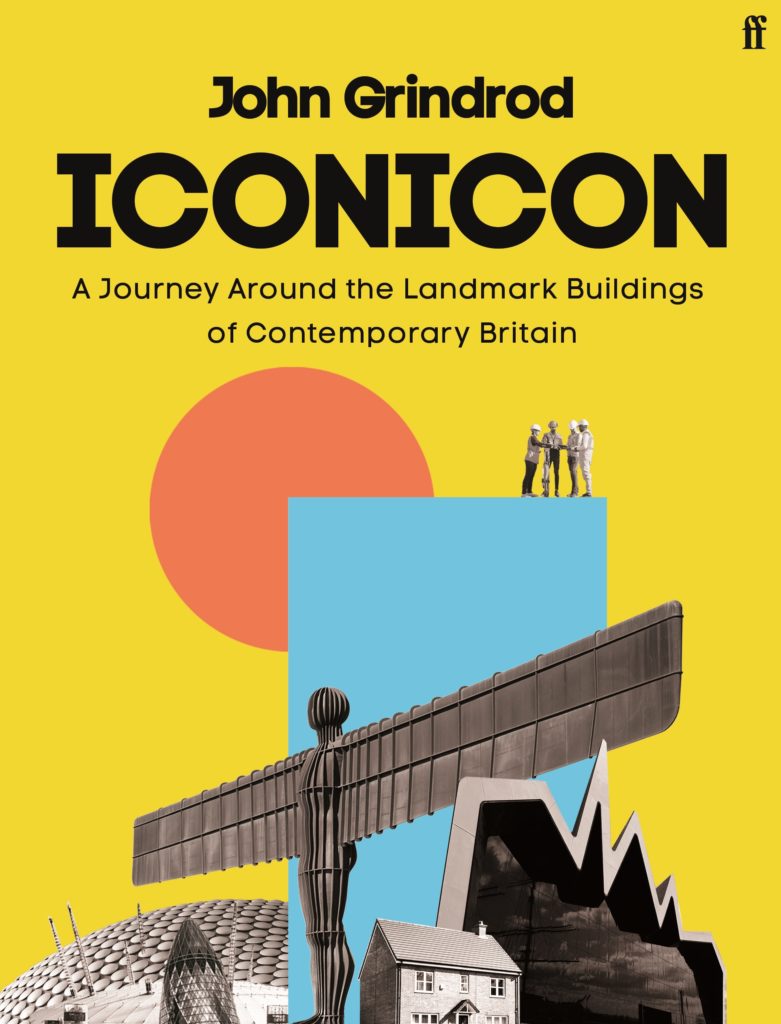‘Iconicon’ by John Grindrod reviewed by Alistair Fitchett

With his 2013 book Concretopia John Grindrod took us on an illuminating tour of Britain’s Post War (New) townscapes. A place and time where mid-century Modernist style and a sense of social responsibility rubbed shoulders with seedy, greedy corruption, it neatly lays the groundwork for Iconicon, in which the author embarks on a journey around the landmark buildings of Britain from 1980 to the present day.
Structured in three parts that broadly mirror UK government shifts from Thatcherite Tory to Blairite (New) Labour and back again to Coalition/Johnson Tory, the book is as much about social and political history as it is about architecture; inevitably so as there is a intrinsic relationship between governance and building, be that in the form of predominantly public funded projects such as those to celebrate the Millennium or in the endless expanses of housing driven by private developers. Grindrod elegantly weaves each of these threads into the body of Iconicon whilst also doing an admirable job of balancing historical context with architectural detail. Each element ably supports the other with seamless transitions, like an unlikely double act feeding each other lines. Or, in the language of architectural illustration, balancing the broad sweeps of exterior perspectives with exquisite pen drawings of entrance detailing. Just so.
Now during my own brief flirtation with architecture at Glasgow’s Macintosh School in the early 80s, one of the things I found most off-putting was the dryness of the writing about the subject. Inevitably this says much more about my ludicrously immature 17 year old self than anything else, but I really did long for someone to write about architecture the way ‘Smash Hits’ wrote about Pop music. John Grindrod doesn’t quite summon the spirit of Neil Tennant’s ‘Bitz!’ but there is certainly an agreeable degree of pop cultural reference threading through everything (Heaven 17, Blur and MGMT provide the titles of the book’s three sections, for example). So whilst Iconicon may be less subjective than Concretopia in the sense that it necessarily covers architectural styles straying from Grindrod’s core passion of Modernism, this pop-cultural influence means that a significant amount of the author’s personality still seems to seep through the pages. This is no bad thing.
The book starts in 1980, and whilst the polarising ‘greed is good’ mantra of that decade has made it very difficult to be objective in retrospect, particularly for anyone who lived through it, Grindrod manages to navigate through this landscape with a deft awareness of the opposing forces of hyper-capitalism/neoliberalism and social(ist) responsibility. In this he comes across very much like Andy Beckett in the excellent Promised You A Miracle, adroitly balancing an acknowledgement that some kind of transition to a post-Industrial (and, indeed, Post-Modern) society was arguably necessary whilst addressing the thought that perhaps Thatcher’s ideologically driven demonisation and demolition of working class solidarity was A Bit Much. Indeed, Thatcherism’s ‘Right To Buy’ flagship policy is in many ways the single common thread that unites each of the three parts of Iconicon; a spark that really ignited the peculiarly British obsession with Property (and it’s attendant, apparently self-perpetuating media circus) and where the economic cycles of boom and bust have arguably caused the most pain.
These days, meanwhile, it seems to be very fashionable to be unapologetically damning of Tony Blair’s New Labour period of government, yet Grindrod does a fine job of capturing the tangible air of optimism that pervaded the country after decades of Tory dissolution. At the heart of this period in the book lie the twin thrusts of devolved governance to Scotland, Wales and Northern Ireland and the Millennium projects, each of which are dealt with in enough detail to keep one engaged and informed, but neither are so lengthy as to leave one bored and anxious to move onto the next part of the story. It’s a tricky skill to master, but Grindrod has done so admirably.
As the book progresses through more recent times it naturally becomes much more difficult to be objective about political and social aspects within a broader historical context. Grindrod gives it a decent go, although it’s never too difficult to guess where his allegiances and sensibilities might lie. The chapter on the Grenfell disaster in particular does a masterful job of simultaneously breaking and hardening one’s heart, its place in our collective memory still too close and the emotions too raw to allow anyone off the many significant hooks that continue to dangle. With a righteous indignation and anger tempered by anguish at the human cost, Grindrod does a sterling job of placing the tragedy within both the political and building contexts, thereby once again illuminating the inextricable connections between the two.
It would be easy, then, to leave ‘Iconicon’ in something of a negative, even desperate frame of mind and it is to Grindrod’s great credit that he does not do so. Instead, like Barnabas Calder in Architecture: From Prehistory to Climate Emergency, Grindrod chooses to find fragments of hope and positivity in the work of young architects and planners working below the radar of our neoliberal overlords. There is a hope and a trust that these fragmentary independents may be united by something beyond the stifling soundbites of populism and are bound instead by the soft yet strong societal fabric of decency, kindness and mutual respect. Solidarity based on shared humanity rather than divisive ideology. One can’t help but look forward to the built environment such trajectories might lead to, and one rather hopes that John Grindrod will be there to write about them.
‘Iconicon’ (Faber & Faber) is out now and available here priced £20.00